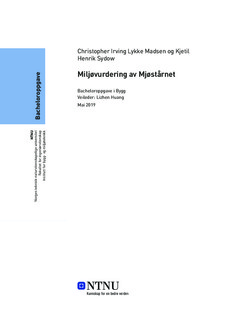| dc.contributor.advisor | Huang, Lizhen | |
| dc.contributor.author | Madsen, Christopher Irving Lykke | |
| dc.contributor.author | Sydow, Kjetil Henrik | |
| dc.date.accessioned | 2019-09-06T14:01:57Z | |
| dc.date.available | 2019-09-06T14:01:57Z | |
| dc.date.issued | 2019 | |
| dc.identifier.uri | http://hdl.handle.net/11250/2613132 | |
| dc.description.abstract | Mjøstårnet, som ruver 85,4 meter over bakken, er til dags dato verdens høyeste trebygg. Det er i denne bacheloroppgaven gjennomført en miljøvurdering av deler av bygget hvor det også er sett på noen mulige forbedringstiltak. Det er i denne oppgaven satt særlig fokus på CO2-utslipp som følge av økende engasjement i verden for å redusere CO2-utslippet, blant annet for å nå 2-gradersmålet. Bruk av treprodukter er i denne sammenheng gunstig på grunn av stor biogen lagringskapasitet. Hovedbæringen i bygget er av limtre og det anslås at 1 m3 limtre lagrer 608 kg CO2.
Oppgaven har bestått i å hente ut mengden materialer fra en virtuell modell av bygget, og legge verdiene i et program for å foreta miljøvurderinger. Miljøvurderingene omhandler kun produksjon av materialer og transport til byggeplassen. Mjøstårnet er unikt og var alltid tiltenkt å være i treverk, det finnes derfor ingen versjon av bygget i andre materialer. Dette har gjort at det umulig å sammenligne forskjellige byggemetoder for bygget. For å få et mer helhetlig bilde er det i tillegg sett på andre klimautslipp. Dette er med på å gi et mer nyansert bilde av hvilke bidrag de forskjellige materialene har.
Resultatene viser at selv om limtre er gunstig med tanke på CO2, bidrar det i stor grad til andre klimautslipp, spesielt når det kommer til svevestøv. Dette viser at man ikke kun kan se på én form for utslipp for å avgjøre om et materiale er mer gunstig for miljøet, enn andre materialer. Samtidig viser det også at bruk av treprodukter har negativ klimapåvirkning selv om det er gunstig med tanke på CO2. LCA analysen hentyder at materialer og transport har et CO2 utslipp på 3 393,8 tonn og en biogen lagring på 3 309,7 tonn. Dette gir en CO2 påvirkning på 83,1 tonn, noe som er veldig lavt for et så stort bygg. | |
| dc.description.abstract | Mjøstårnet towering 85,4 meters above the ground is the world’s tallest wooden building to date. In this bachelor’s thesis, an environmental assessment has been carried out with a focus on only certain parts of the building, while having possible improvements in mind. Considering the growing attention to reducing CO2 emissions especially with the “2-degree Celsius limit” in mind, this bachelor thesis task has a main focus on CO2 emissions. The use of wood products in this context is favourable due to its large biogenic storage. The structural frame in the building consists of glulam and it has been estimated that 1 m3 of laminated glulam-timber stores 608 kg of CO2.
This assignment has consisted of extracting values from a virtual model of Mjøstårnet and added the values into an environmental impact assessment program. Due to lack of information, the environmental assessment deals only with the production of materials and transport to the construction site. Mjøstårnet was always intended to be constructed only in wooden materials, therefore there is no other versions of the building in other materials. Because of this it has not been possible to compare different building methods for constructing the building. To get a more complete picture the assignment also takes other climate emissions into consideration. This gives a more nuanced picture of how different materials contribute to emissions.
The results show that although glulam is favourable with regard to CO2, it contributes largely to other climate emissions, especially regarding particulate pollution. This shows that one can not only have one form of emissions in mind when determining if one sort of material is favourable compared to another form of material. At the same time, it also shows that unnecessary use of wood products leads to emissions even though it is favourable with regards to CO2. The LCA analysis indicates that materials and transport have a CO2 emission of 3 393,8 tonnes and a biogenic storage of 3 309,7 tonnes, this gives a CO2 impact of 83,1 tonnes, which is very low for such a large building. | |
| dc.language | nob | |
| dc.publisher | NTNU | |
| dc.title | Miljøvurdering av Mjøstårnet | |
| dc.type | Bachelor thesis | |
